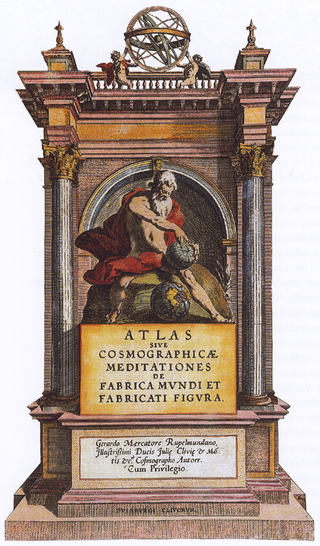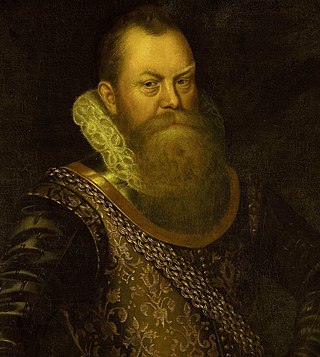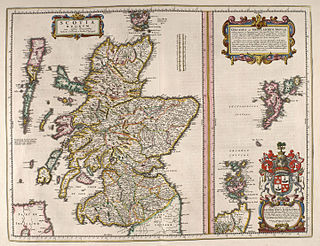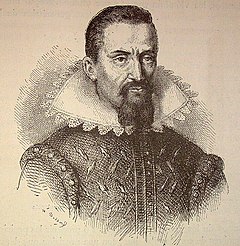
Lactose, or milk sugar, is a disaccharide sugar composed of galactose and glucose subunits and has the molecular formula C12H22O11. Lactose makes up around 2–8% of milk (by mass). The name comes from lact (gen. lactis), the Latin word for milk, plus the suffix -ose used to name sugars. The compound is a white, water-soluble, non-hygroscopic solid with a mildly sweet taste. It is used in the food industry.

Stout is a dark beer that is generally warm fermented, such as dry stout, oatmeal stout, milk stout and imperial stout, though can also be cold fermented, such as Baltic porter.

An atlas is a collection of maps; it is typically a bundle of maps of Earth or of a continent or region of Earth.

The Houtman Abrolhos is a chain of 122 islands and associated coral reefs, in the Indian Ocean off the west coast of Australia, about 80 kilometres (50 mi) west of Geraldton, Western Australia. It is the southernmost true coral reef in the Indian Ocean, and one of the highest latitude reef systems in the world.

Cornelis de Houtman was a Dutch merchant seaman who commanded the first Dutch expedition to the East Indies. Although the voyage was difficult and yielded only a modest profit, Houtman showed that the Portuguese monopoly on the spice trade was vulnerable. A flurry of Dutch trading voyages followed, eventually leading to the displacement of the Portuguese and the establishment of a Dutch monopoly on spice trading in the East Indies.

Yogurt is a food produced by bacterial fermentation of milk. Fermentation of sugars in the milk by these bacteria produces lactic acid, which acts on milk protein to give yogurt its texture and characteristic tart flavor. Cow's milk is most commonly used to make yogurt. Milk from water buffalo, goats, ewes, mares, camels, and yaks is also used to produce yogurt. The milk used may be homogenized or not. It may be pasteurized or raw. Each type of milk produces substantially different results.

Lactic acid fermentation is a metabolic process by which glucose or other six-carbon sugars are converted into cellular energy and the metabolite lactate, which is lactic acid in solution. It is an anaerobic fermentation reaction that occurs in some bacteria and animal cells, such as muscle cells.

Frederick de Houtman was a Dutch explorer, navigator, and colonial governor who sailed on the first Dutch expedition to the East Indies from 1595 until 1597, during which time he made observations of the southern celestial hemisphere and contributed to the creation of 12 new southern constellations.
The year 1627 in science and technology involved some significant events.

The year 1843 in science and technology involved some significant events, listed below.
The Cursor Mundi is an early 14th-century religious poem written in Northumbrian Middle English that presents an extensive retelling of the history of Christianity from the creation to the doomsday. The poem is long, composed of almost 30,000 lines, but shows considerable artistic skill. In spite of the immense mass of material with which it deals, it is well proportioned, and the narrative is lucid and easy.

Johannes de Sacrobosco, also written Ioannes de Sacro Bosco, later called John of Holywood or John of Holybush, was a scholar, monk, and astronomer who taught at the University of Paris.

Baron Charles Athanase Walckenaer was a French civil servant, writer, man of letters, and scientist. He was a polymath and wrote extensively on geography, natural history, and literature. Major contributions included his multi-volume natural histories of arachnids and insects, some published in collaboration with others. He was made a baron in 1823.

Cornish literature refers to written works in the Cornish language. The earliest surviving texts are in verse and date from the 14th century. There are virtually none from the 18th and 19th centuries but writing in revived forms of Cornish began in the early 20th century.
The earliest known world maps date to classical antiquity, the oldest examples of the 6th to 5th centuries BCE still based on the flat Earth paradigm. World maps assuming a spherical Earth first appear in the Hellenistic period. The developments of Greek geography during this time, notably by Eratosthenes and Posidonius culminated in the Roman era, with Ptolemy's world map, which would remain authoritative throughout the Middle Ages. Since Ptolemy, knowledge of the approximate size of the Earth allowed cartographers to estimate the extent of their geographical knowledge, and to indicate parts of the planet known to exist but not yet explored as terra incognita.
The year 1599 in science and technology involved some significant events.
Dáibhí Iarla Ó Cróinín is an Irish historian and authority on Hiberno-Latin texts, noted for his significant mid-1980s discovery in a manuscript in Padua of the "lost" Irish 84-year Easter table. Ó Cróinín was Professor of History at NUI Galway and Member of the Royal Irish Academy. He specialises in the history of Ireland, Britain and Europe during the Middle Ages and Hiberno-Latin texts.
The year 1571 in science and technology included a number of events, some of which are listed here.
"Jerusalem the Golden" is a nineteenth-century Christian hymn by John Mason Neale. The text is from Neale's translation of a section of Bernard of Cluny's Latin verse satire De Contemptu Mundi.

The book commonly known as Blaeu Atlas of Scotland, the fifth volume of Theatrum Orbis Terrarum Sive Atlas Novus, is the first known atlas of Scotland and Ireland. It was compiled by Joan Blaeu, and contains 49 engraved maps and 154 pages of descriptive text written in Latin; it was first published in 1654. Most of the maps were made by Timothy Pont, a Scottish cartographer. Those maps, made between 1583 and 1596, were collected, edited, and augmented with other maps by John Scot, Lord Scotstarvit, a Scottish laird.













